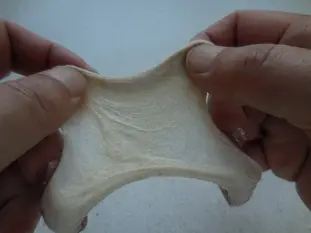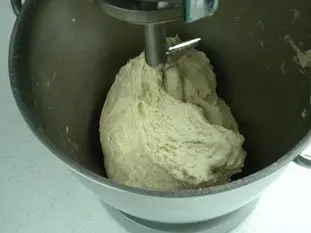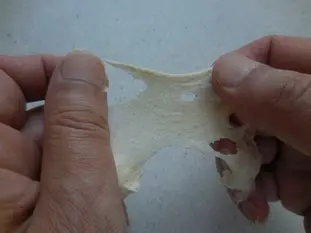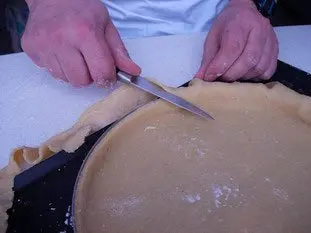The window-pane test in bread-making

The home bread-makers often ask themselves “Have I kneaded my dough long enough?” . A good question, as dough that is insufficiently kneaded will not rise properly or will fall flat when the top is slashed, which is very frustrating.
To know when the dough is ready, one can rely on the length of kneading time shown in the recipe or test the temperature, but both can be unreliable guides. It is better to check visually if the dough is sufficiently well kneaded. Then one can say, “OK, let's stop there” , or “No, that needs a bit longer” .
To check the dough visually, like the professionals do, we need to check for the “window-pane” effect, also known as the membrane test.
To know when the dough is ready, one can rely on the length of kneading time shown in the recipe or test the temperature, but both can be unreliable guides. It is better to check visually if the dough is sufficiently well kneaded. Then one can say, “OK, let's stop there” , or “No, that needs a bit longer” .
To check the dough visually, like the professionals do, we need to check for the “window-pane” effect, also known as the membrane test.
Last modified on: June 16th 2021
The window-pane test in bread-making
Behind this mysterious name lies a very physical phenomenon: when dough is kneaded, the gluten in the flour forms a structure, like a kind of net, which holds the dough together. This gluten network gives the dough its elasticity and traps the C02 formed during fermentation to create the “bubbles” which will become the open spaces in the bread.
If you stretch well-kneaded dough, the gluten network will prevent it breaking immediately, so it is possible to stretch it out very thinly, indicating that the gluten network is properly developed.
So, the test is very simple: if the membrane is there, the dough has been kneaded long enough. If not, continue kneading.
To sum up :The presence or absence of the translucent membrane is the best indicator of whether bread dough is sufficiently kneaded or not.
But not all dough in baking is the same: this membrane should be looked for in bread dough as a sign of elasticity. However, for tart pastry, it is quite the contrary: we don't want the dough to be stretchy and develop the gluten membrane. So, for pastry, the dough should be kneaded as little as possible.
If you stretch well-kneaded dough, the gluten network will prevent it breaking immediately, so it is possible to stretch it out very thinly, indicating that the gluten network is properly developed.
So, the test is very simple: if the membrane is there, the dough has been kneaded long enough. If not, continue kneading.

Now, of course, we need to know how to check whether the membrane is there or not.
To do this, stop kneading and take a small piece of dough, about the size of a walnut. Stretch this out gently: if the dough tears easily, the membrane is not yet developed and you will need to continue kneading, like in this photo:

If, on the contrary, the dough does not tear, but can be stretched out into a thin, translucent membrane, you can stop kneading. This is shown here:

Here ios a small video to show you the gesture and the result:
To sum up :The presence or absence of the translucent membrane is the best indicator of whether bread dough is sufficiently kneaded or not.
But not all dough in baking is the same: this membrane should be looked for in bread dough as a sign of elasticity. However, for tart pastry, it is quite the contrary: we don't want the dough to be stretchy and develop the gluten membrane. So, for pastry, the dough should be kneaded as little as possible.

Lasts posts
Who's making the croissants?
When you look at a bakery from the outside, you naturally think that in the bakery, the bakers make the bread, and in the laboratory, the pastry chefs make the cakes. It's very often like that, with each of these professions having quite different ways of working, but sometimes there's also one...November 23th 2025586
Oven height
When we put a dish or cake in the oven, we naturally tend to put it on the middle shelf, and that's what we usually do. But in some cases, this position and height can be a little tricky, so let's find out why.October 8th 20252,1195
The importance of sieving
In recipes that use a fine powder (flour, powdered sugar, etc.), you'll often see the advice to sift before using it. To sift is to pass the powder in question through a sieve (a very fine strainer) before incorporating it into your recipe. It's often advice, but is it really useful?September 3rd 20257,1683
The grease spray
As soon as you have something in a recipe that sticks to the mold, the question always arises as to how difficult it is to remove from the mold. There's nothing more frustrating than breaking your cake when unmolding it, because part of it has stuck in the mold. The classic way to avoid this is...August 26th 20256,6835
Cake moulds
When we make a cake, or a cake of the same rectangular shape, we usually take out our usual mould and tell ourselves that the recipe is anyway "for a cake", but is it really that simple?August 25th 20256,7225
Other pages you may also like
Egg yolks and caster sugar
We often come across recipes where we need to mix egg yolks with caster sugar. This would appear to be a very ordinary and simple thing to do but, be warned, these two ingredients can behave oddly together.February 15th 201882 K 24.3
The super powers of cornstarch
I start this new year by evoking an old product, that you most probably have in your cupboards, a white powder, often in a small cardboard package with a slightly outdated look, only the "gluten free" is relatively recent, it is simply cornstarch, hence its name of maïzena. It's used for a lot...January 14th 202215 K
Fruits which can ruin your jelly
There are many ways of making a fruit mousse, but one of the simplest is to prepare a fruit jelly (basically a fresh fruit coulis with gelatine) and then mix this jelly before it sets completely with whipped cream. The result is perfect for filling a charlotte, for example. But do beware;...March 6th 201378 K4.0
A few tips for effective kneading at home
When you have to knead dough for bread or some other recipe, you may well use a food processor or the type of machine known as a stand mixer. The best-known brands are Kenwood and KitchenAid. They are useful tools, but here are a few tips to help you get the best out of them.June 23th 2021283 K 23.8
The beautiful story of the croissants
As you may have already noticed, cooking, baking and pastry-making are full of stories or legends, usually very romantic, about this or that product or recipe. This is often the case for named recipes, for example tarte tatin, peach melba, paris-brest and many others, but it also applies to very...October 10th 201819 K5
Follow this page
If you are interested in this page, you can "follow" it, by entering your email address here. You will then receive a notification immediately each time the page is modified or a new comment is added. Please note that you will need to confirm this following.
Note: We'll never share your e-mail address with anyone else.
Alternatively: you can subscribe to the mailing list of cooling-ez.com , you will receive a e-mail for each new recipe published on the site.










The 2 comments already posted on this page
Professional baker (good ones) make it a dozen a day, because they want to be sure of their doughs, despite the flour, temperature of the day, hydrometry, amount of water, etc.
But I think you're wrong when you say you could check "kneaded sufficient just by the way it looks and feels", sorry, no, it's a beginner mistake (believe me, I made it some time... when I was in bakery school) looking at the dough and claim that it's enough, especially if you have soft doughs like milk rolls, who could be smooth, because of the butter and milk in, but not enough kneaded.
And I don't agree neither when you say "it's usually better to err on the side of overkneading than underkneading", no, it's the opposite when overkneaded, it's over, failed, can't be fixed, but if you're underkneaded, you can fix it by a longer first rest (pointage) than usually planned.